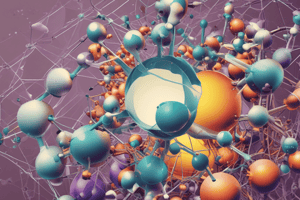Podcast
Questions and Answers
What characterizes an organohalide?
What characterizes an organohalide?
- Contains at least one carbon-carbon bond
- Contains only carbon and hydrogen
- Contains at least one carbon-halogen bond (correct)
- Contains at least one carbon-fluorine bond
What is the preferred approach for numbering the carbon chain when naming alkyl halides?
What is the preferred approach for numbering the carbon chain when naming alkyl halides?
- Number from the end nearest any substituent (correct)
- Number from either end as desired
- Number from the end nearest the longest carbon chain
- Number from the middle of the chain
What effect does halogenation have on the strength of the C-X bond as you move down the periodic table?
What effect does halogenation have on the strength of the C-X bond as you move down the periodic table?
- C-X bonds become weaker (correct)
- C-X bonds become stronger
- C-X bonds remain unchanged in strength
- C-X bonds double in strength
When performing radical halogenation of alkanes, which hydrogen is most likely to be replaced?
When performing radical halogenation of alkanes, which hydrogen is most likely to be replaced?
Why is radical halogenation often not recommended for synthesizing alkyl halides?
Why is radical halogenation often not recommended for synthesizing alkyl halides?
What factor primarily determines the order of relative reactivity in the bromination of alkenes?
What factor primarily determines the order of relative reactivity in the bromination of alkenes?
Which statement best describes allylic bromination using N-bromosuccinimide (NBS)?
Which statement best describes allylic bromination using N-bromosuccinimide (NBS)?
How does the stability of an allyl radical compare to a tertiary alkyl radical?
How does the stability of an allyl radical compare to a tertiary alkyl radical?
What is the primary method for converting tertiary alcohols to alkyl halides?
What is the primary method for converting tertiary alcohols to alkyl halides?
What is the role of resonance in the stability of the allyl radical?
What is the role of resonance in the stability of the allyl radical?
What is the product when an alkyl halide reacts with magnesium in ether or THF?
What is the product when an alkyl halide reacts with magnesium in ether or THF?
What is the requirement for the alkyl group in the formation of Grignard reagents?
What is the requirement for the alkyl group in the formation of Grignard reagents?
Which of the following statements is true regarding the order of reactivity of halides in Grignard reactions?
Which of the following statements is true regarding the order of reactivity of halides in Grignard reactions?
In the Suzuki-Miyaura reaction, what type of compounds are coupled together?
In the Suzuki-Miyaura reaction, what type of compounds are coupled together?
What is the final product when RLi reacts with copper iodide?
What is the final product when RLi reacts with copper iodide?
What defines oxidation in organic chemistry?
What defines oxidation in organic chemistry?
Which statement is true regarding the SN2 reaction?
Which statement is true regarding the SN2 reaction?
What characterizes the transition state of an SN2 reaction?
What characterizes the transition state of an SN2 reaction?
What is a primary factor in the rate of a nucleophilic substitution reaction?
What is a primary factor in the rate of a nucleophilic substitution reaction?
Which type of alkyl halide is least reactive towards an SN2 reaction?
Which type of alkyl halide is least reactive towards an SN2 reaction?
Which of the following describes a nucleophile in the context of alkyl halide reactions?
Which of the following describes a nucleophile in the context of alkyl halide reactions?
What is the effect of steric hindrance on the SN2 reaction?
What is the effect of steric hindrance on the SN2 reaction?
Which of the following represents a reduction reaction in organic chemistry?
Which of the following represents a reduction reaction in organic chemistry?
What type of reaction is favored by tertiary alkyl halides in polar protic solvents?
What type of reaction is favored by tertiary alkyl halides in polar protic solvents?
Which factor primarily affects the rate of SN1 reactions?
Which factor primarily affects the rate of SN1 reactions?
What is a key characteristic of the SN2 reaction mechanism?
What is a key characteristic of the SN2 reaction mechanism?
Which solvent type is most favorable for SN2 reactions?
Which solvent type is most favorable for SN2 reactions?
What does Zaitsev's Rule state about elimination reactions?
What does Zaitsev's Rule state about elimination reactions?
In what way does the leaving group affect an SN2 reaction?
In what way does the leaving group affect an SN2 reaction?
What distinguishes E1 reactions from E2 reactions?
What distinguishes E1 reactions from E2 reactions?
How does the presence of an ion pair affect the outcome of an SN1 reaction?
How does the presence of an ion pair affect the outcome of an SN1 reaction?
What role does the nucleophile play in SN1 reaction kinetics?
What role does the nucleophile play in SN1 reaction kinetics?
Which alkyl halide is expected to react fastest in an SN2 reaction?
Which alkyl halide is expected to react fastest in an SN2 reaction?
Flashcards
Organohalide
Organohalide
An organic compound that contains at least one carbon-halogen (C-X) bond, where X represents a halogen atom like fluorine (F), chlorine (Cl), bromine (Br), or iodine (I).
Radical Halogenation
Radical Halogenation
The process of creating an alkyl halide by replacing a hydrogen atom in an alkane with a halogen atom (Cl or Br) using heat or light. This involves a free radical mechanism.
Alkyl Halide
Alkyl Halide
A chemical compound derived from an alkane by replacing one or more hydrogen atoms with halogen atoms.
Halogenation of Alkanes
Halogenation of Alkanes
Signup and view all the flashcards
Substitution Preference in Radical Halogenation
Substitution Preference in Radical Halogenation
Signup and view all the flashcards
Relative Reactivity
Relative Reactivity
Signup and view all the flashcards
Allylic Bromination
Allylic Bromination
Signup and view all the flashcards
Allyl Radical
Allyl Radical
Signup and view all the flashcards
Why Allyl Radical is Stable
Why Allyl Radical is Stable
Signup and view all the flashcards
Rearrangements in Alcohol Reactions
Rearrangements in Alcohol Reactions
Signup and view all the flashcards
Organometallic Coupling
Organometallic Coupling
Signup and view all the flashcards
Organometallic Reagent
Organometallic Reagent
Signup and view all the flashcards
Grignard Reagent
Grignard Reagent
Signup and view all the flashcards
Suzuki-Miyaura Reaction
Suzuki-Miyaura Reaction
Signup and view all the flashcards
Gilman Reagent
Gilman Reagent
Signup and view all the flashcards
SN2 Reaction
SN2 Reaction
Signup and view all the flashcards
SN2 Reaction Kinetics
SN2 Reaction Kinetics
Signup and view all the flashcards
SN2 Transition State
SN2 Transition State
Signup and view all the flashcards
Steric Effects in SN2
Steric Effects in SN2
Signup and view all the flashcards
SN2 Nomenclature
SN2 Nomenclature
Signup and view all the flashcards
Elimination Reaction
Elimination Reaction
Signup and view all the flashcards
Oxidation-Reduction in Organic Chemistry
Oxidation-Reduction in Organic Chemistry
Signup and view all the flashcards
Electrophile
Electrophile
Signup and view all the flashcards
Steric Hindrance in SN2
Steric Hindrance in SN2
Signup and view all the flashcards
Nucleophile Strength in SN2
Nucleophile Strength in SN2
Signup and view all the flashcards
Leaving Group in SN2
Leaving Group in SN2
Signup and view all the flashcards
Protic Solvents in SN2
Protic Solvents in SN2
Signup and view all the flashcards
Aprotic Solvents in SN2
Aprotic Solvents in SN2
Signup and view all the flashcards
SN1 Mechanism
SN1 Mechanism
Signup and view all the flashcards
Substrate in SN1
Substrate in SN1
Signup and view all the flashcards
Solvent Effects in SN1
Solvent Effects in SN1
Signup and view all the flashcards
Elimination Reactions vs Substitution
Elimination Reactions vs Substitution
Signup and view all the flashcards
Zaitsev's Rule
Zaitsev's Rule
Signup and view all the flashcards
Study Notes
Alkyl Halides
- Alkyl halides are organic compounds containing at least one carbon-halogen bond (C-X)
- X is a halogen (F, Cl, Br, or I) replacing a hydrogen atom
- Can have multiple C-X bonds
- Used in various applications, including refrigerants, solvents, and pharmaceuticals
Nomenclature of Alkyl Halides
- Identify the longest carbon chain as the parent chain
- Number the chain from the end closest to any substituent (alkyl or halogen)
- Substituents are listed alphabetically in the name
- If two substituents are equidistant from the ends, begin numbering from the end that places the substituent with the lower alphabetical order first in the name
Alkyl Halide Synthesis from Alkanes
- Radical halogenation: Replacing a C-H bond with a C-X bond.
- Generates mixtures of products, not typically a good synthetic method
- The reaction is initiated by light or heat, and forms free radicals
- Alkyl halides can also be prepared by addition of HCl, HBr, or HI to alkanes.
Alkyl Halide Synthesis from Alcohols
- Tertiary alcohols react quickly and efficiently with HX to produce alkyl halides
- Primary and secondary alcohols react very slowly and often rearrange, so other methods are used
Organometallic Reagents for Alcohol Synthesis
- A covalent bond between carbon and metal (e.g., Mg, Li) makes carbon nucleophilic
- Grignard reagents are formed by the reaction of alkyl halides with Mg.
- Alkyllithium reagents are formed by the reaction of alkyl halides with Li.
Organometallic Coupling Reactions
- Alkyllithium reacts with copper iodide to form lithium dialkylcopper (Gilman reagents)
- Suzuki-Miyaura reaction couples aryl or vinyl substituted boronic acids with aryl or vinyl substituted organohalides in the presence of palladium catalyst.
Oxidation and Reduction in Organic Chemistry
- Oxidation in organic chemistry occurs when a carbon or hydrogen is substituted by a more electronegative atom (oxygen, nitrogen, or halogen)
- Oxidation reactions result in a loss of electron density at a carbon atom.
- Reduction reactions result in a gain of electron density at a carbon atom by substituting with hydrogen or by breaking a C-O, C-N, or C-X bond.
SN1 Reaction
- Tertiary alkyl halides react rapidly in protic solvents via an SN1 mechanism.
- Two steps: leaving group departs first followed by reaction with nucleophile.
- Carbocation intermediate is formed, which is achiral
- Produces racemic mixtures (equal amounts of both enantiomers), or mixtures with some inversion
- Stability of carbocation is important factor in reactivity.
SN2 Reaction
- Methyl and primary alkyl halides undergo SN2 reactions readily.
- One-step mechanism: simultaneous attack of nucleophile and departure of leaving group.
- Stereospecific: nucleophile attacks at the back of the leaving group causing inversion of configuration.
- Rate is dependent on concentration of both substrate and nucleophile.
- Steric hindrance affects the efficiency of the reaction: alkyl groups around reacting carbon make reaction slower.
Elimination Reactions
- Alternative pathway from substitution.
- Generates an alkene
E1 and E2 Reactions
- Competing pathways with SN1 and SN2
- E2 occurs with a strong base; requires concerted step
- E1 occurs in multiple steps. involves carbocation intermediate.
Zaitsev's Rule
- In elimination reactions, the more highly substituted alkene is usually the major product.
Comparing E1 and E2 Reactions
- Reactions depend on base strength and steric hindrance.
Summary of Reactivity
- Alkyl halides react in various ways depending on the reacting molecule and conditions
- Reactivity is based on patterns that predict outcomes of reactions.
Studying That Suits You
Use AI to generate personalized quizzes and flashcards to suit your learning preferences.
Related Documents
Description
This quiz covers key concepts related to alkyl halides, including their structure, reactivity, and the effects of halogenation. It discusses important reactions like radical halogenation and the formation of Grignard reagents. Test your understanding of these foundational topics in organic chemistry.




